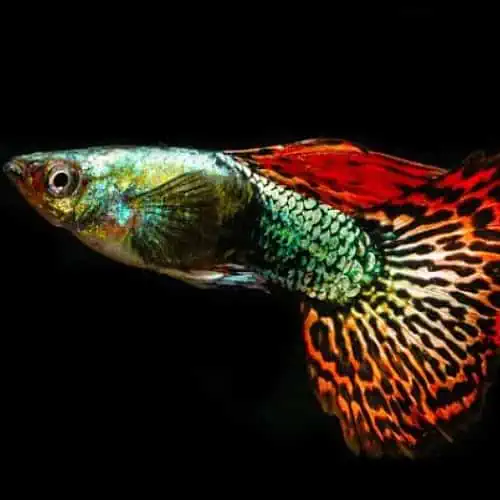
Originally discovered in Venezuela in 1859, guppies are tiny (they’re only about 2.5 inches long!) tropical fish that, in spite of their nativity to southern climes, are able to do well in waters around the world. This, combined with their hardiness as well as the plethora of unique and attractive varieties that are available, make them a very popular aquarium and pond fish.
Though most people associate them with aquariums, stocking them in outdoor ponds may actually be more beneficial – they’re more likely to breed, if that’s something you want, they consume mosquitos as well as algae, and an outdoor pond is a much more natural habitat for them than an indoor, confined aquarium.
Do Guppies Eat Mosquito Larvae? (And Other Benefits)

In fact, many portions of the world have utilized guppies to help control mosquito populations and thereby lessen the risk of transmission of mosquito-borne illnesses (the downside being the invasiveness of guppies when used outside of their native, tropical Central American range).
One study further backed up the validity of this method by finding that water systems with guppies had 30% fewer mosquitos than those without guppies after only a month of introducing the guppies to the water. This makes guppies a great addition to already established ponds as a mosquito deterrent, or as an aesthetic centerpiece fish in their own little patio pond to keep bugs away in summer.
As well as this, they’re fairly hardy when kept in the right conditions, are easy to breed, have a very friendly temperament , and love their grub – so it’s always fun to watch them eat!
Guppy Pond Stocking & Pond Size
- All-in-one/ easy-to-install pond kit water feature requires no digging
- Includes a 40"x20"x18"-inch contemporary above ground water feature/ pump/ fountain heads and underwater light
- Durable and rugged rotomolded construction/ won't chip/ crack/ or fade. Perfect as an above ground water feature
First and foremost, keep in mind that guppies are quite small and should therefore not be stocked with larger predatory fish. They need a minimum of 5 gallons per guppy, meaning that they are suitable for anything from mini-bowls to lakes. Though they do just fine in only a few inches of water, an outdoor pond should be at least a foot or two deep to help prevent it from heating up too quickly in the sun (or freezing entirely in the winter) and potentially stressing or killing the guppies.
If you don’t intend to breed guppies, making use of a small all-in-one patio kit (pictured) which includes an aerator, pump, lights and sufficient volume is a great way to get started with outdoor guppies. Plus, it’s easy to bring indoors during the winter!
In addition, they reproduce very quickly if conditions are right (their nickname is the “millions fish” for this reason), so if you’re looking to breed, you’ll either need a pond large enough to accommodate their population growth and/or to periodically remove some of them with a net. Many pet shops are happy to take guppies, as they’re a popular fish among aquarists and ponders alike.
Guppy Pond Water Quality & Temperature
- Contains one (1) API POND MASTER TEST KIT Pond Water Test Kit 500-Test, including 6 bottles of testing solution, 3 color cards and 4 test...
- Helps monitor water quality and prevent invisible water problems that can be harmful to fish
- Measures ornamental pond pH balance, Ammonia content, Nitrite levels and Phosphate content
Despite being tropical fish, guppies do well in water temperatures that range from 55 all the way up to 86° F (13 to 30° C), though they do best in the 70s (21-26° C). During the winter months, if you don’t live in a more temperate region or have measures in place to keep pond temperatures warm enough for the guppies, they may need to be brought indoors. Pond hardness should be kept between 10 and 20° dH, and pH needs to be moderately alkaline at 7 to 8.
As with any fish, regular monitoring of water quality is exceptionally important to ensure that your guppies are healthy. Though a hardy fish, having water that’s not up to par can cause stress, illness, or possibly even death for the guppies. For best results, check your water temperature, pH, hardness, and oxygen levels daily at the same time each day.
Guppy Pond Feeding & Nutrition
As omnivores, guppies eat both plant matter as well as animal proteins and both are an important part of their diet to ensure that they’re getting enough high quality vitamins, minerals, and proteins. Fry require more protein than do adults; studies have found that feeding them between 30 and 50% protein results in the best growth and overall health.
Adults do best with at least 20% protein in their diet, though 30 to 35% seems best for them. Fry need 4 to 6% lipids (fats) and 40 to 50% carbohydrates, while adults need 6 to 8% fats and approximately the same amount of carbohydrates to fuel their relatively fast metabolisms and active nature.
For guppies, the most important minerals are calcium, phosphorus, copper, iodine, iron, magnesium, manganese, selenium and zinc. Phosphorus tops the list and needs to be supplemented to guppies, as it’s crucial for bone development and mineralization, growth, and aids in the proper metabolism of lipids and carbohydrates. Guppies that are phosphorous-deficient may lack appetite, become lethargic, and develop scoliosis and lordosis.
To safeguard that your guppies are getting everything they need, provide them with feed pellets (the ones created specifically for guppies) once or twice daily, only feeding them as much as they can eat in 3 to 5 minutes. These combined with their natural diets of insects and plant matter should be enough for them.
You can also give them chopped up mustard greens and spinach, shelled peas, zucchini, spirulina, dried foods like brine shrimp and bloodworms, and on rare occasions fruits such as banana and skinned grapes. Fruits shouldn’t be given often, as guppies don’t typically eat fruit in the wild and too many of these natural sugars can be difficult for their bodies to process.
Guppy Pond Setup, Equipment & Extras
Though guppies are small, depending on how many you have as well as your pond’s size (greater than a few hundred gallons) it’s a good idea to still have a small filter and some form of aeration via an air pump, bubbler, waterfall, or some similar structure that encourages water movement and thus air movement. Adding plants helps with both water filtration and oxygenation, though of course are likely not enough on their own since guppies are active swimmers and thus need to have 7 ppm or more of dissolved oxygen.
They enjoy having hiding places, so floating and submerged plants in addition to some rocks and hollowed out areas in logs and/or substrate will keep them happy and safe from potential predators like birds, turtles, or other larger fish.
If you live in a cool region and plan on trying to keep the guppies outside in the pond during the winter, you’ll also need a pond heater to make sure that the water stays within their required temperature parameters or they will need to be brought indoors into a heated aquarium or holding tank.

I’ve been thinking about having guppies in a pond
would a 110 gal rubber stock tank do the trick? I’d
have them inside a 16X16 shed as my fish area.
I just bought the 100 gallon Tupperware Commercial Grade stock tank (basically, a horse water trough) at my local Tractor Supply. I had previously used the thinner 4-50 gallon totes, but the tended to bulge when full of water and I was concerned about cracking after a summer of heat and temperature changes
Look on YouTube for “summer tubbing” (Rachel O’Leary is quite good, as is Michael’s Fish Room, and of course Aquarium Coop has good advice)
1- year plus update:
100 gallon Tupperware stock tub
Two 500W aquarium heaters
Two large Aquarium Coop sponge filters
Dual port air pump (to run sponge filters)
One 8×10′ canvass
Two 4×2′ greenhouse polycarb panels
Fashioned a 2×4 frame around tub to support canvass and panels
Fed guppies every other day, checked temps every day
Uncovered to poly panels for sun on bright days
I had a 2-day stretch over Christmas where temps plummeted below zero, otherwise temps stayed at or above freezing. Tank temp consistent at 70-72 degrees all winter. Over Christmas dropped into 60’s but no loss of fish to my knowledge.
So far this summer, tank is thriving and I’m selling excess water hyacinth, water lettuce and have given away some guppies.
Questions? feel free to contact me
That’s so good this is the project l am doing
That’s great, Oliver! Best of luck with the project. Let us know how it goes.